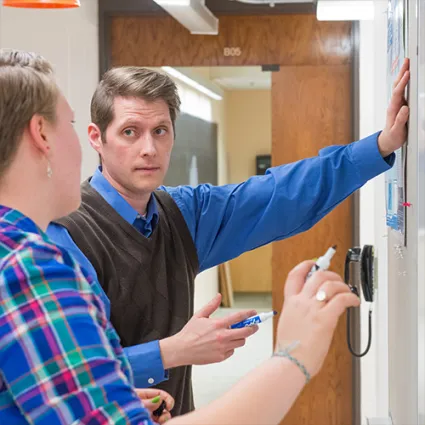Will Raven
Professor of Physics; Chair, Department of Physics

Biography
Prof. Raven joined the Smith College physics department in 2013. Since then, he has mentored over 70 undergraduate researchers, including 15 senior theses, and is passionate about creating research opportunities for students. He has published 8 peer-reviewed articles since 2020 and secured five National Science Foundation (NSF) grants, including the NSF CAREER award. He received the American Physical Society 2025 Prize for a Faculty Member for Research in an Undergraduate Institution in recognition of his contributions to undergraduate education and cutting-edge research. He has also won the Smith College Student Government Association’s (SGA) teaching award twice, once as a junior faculty member and once as a senior faculty member.
Prof. Raven’s research is in the field of high-precision spectroscopy, with a particular focus on measurements that test quantum electrodynamics (QED) and provide data critical for nuclear structure theory. His work involves the spectroscopy of neutral light atoms such as beryllium, boron, nitrogen, and oxygen. Prof. Raven also designed and teaches a course-based research program that performs spectroscopy on the lanthanides. The class, PHY242 Research in High Precision Spectroscopy, has no prerequisites, does not use any calculus, or require any knowledge of physics. It does, however, use algebra and some sines and cosines. To learn more about his research group and the course-based research program, please visit his website.
In addition to his research and teaching, Prof. Raven is the author of a book aimed at introducing first-year college students to atomic and quantum physics without requiring a background in calculus or physics.
Raven, W. (2024). Atomic Physics for Everyone: An Introduction to Atomic Physics, Quantum Mechanics, and Precision Spectroscopy with No College-Level Prerequisites. Springer Nature.
DOI: 10.1007/978-3-031-69507-0
Funding
- 2025 – NSF RUI: PHY-2513044
- 2023 – NSF MRI: PHY-2319917
- 2021 – NSF RUI: PHY-2110311
- 2016 – NSF Early CAREER award: PHY-1555232
- 2014 – NSF MRI: PHY-1428112
Recent Publications
*indicates student author
Will Raven’s publishing name is W.D. Williams
- “High-precision measurement of the 2s2p 1Po1 center of gravity in neutral 9Be at the parts-per-billion level” K. J. Ahrendsen, E. M. Kay,* W. D. Williams, Accepted Physical Review A, July 2025
- “Precision measurement of the absolute energy of the 2s3s 1S0 state in neutral beryllium-9” K. J. Ahrendsen, T. Karani,* and W. D. Williams, Physical Review A, 110, 032818 (2024)
DOI: 10.1103/PhysRevA.110.032818 - “Spectroscopic study of the 4f76s2 8S7/2 – 4f7(8So) 6s6p(1Po) 8P5/2,7/2 transitions in neutral europium-151 and europium-153: absolute frequency and hyperfine structure” C. Maruko,* N. N. Çölmek,* M. T. Herd, K. J. Ahrendsen, B. Cabrales,* G. Cannon,* E. Davis,* X. Y. Guo,* T. Karani,* A. Wallace,* K. Wisnauckas,* and W. D. Williams, Journal of the Optical Society of America B, 41, 5 (2024)
DOI: 10.1364/JOSAB.521181 - “Absolute frequency measurement of the 2p2(3P)3s 2P – 2p2(3P)3p 2Do transitions in neutral 14N” K. J. Ahrendsen, C. Maruko,* K. R. Albert-Aranovich,* Q. Berfield-Brewer,* A. Esseln,* L. Guo,* A. E. Ishimwe,* Y. Kuzniar,* A. E. McKenna,* K. J. Soto Villarreal,* A. Uprety,* L. Vieira da Silva,* K. F. Vogt,* and W. D. Williams, Physical Review A 108, 042815 (2023)
DOI: 10.1103/PhysRevA.108.042815 - “Spectroscopic study of the 4f7 6s2 8S7/2– 4f7 (8S)6s6p (1P) 8P9/2 transition in neutral europium-151 and europium-153: absolute frequency and hyperfine structure” M. T. Herd, C. Maruko,* M. M. Herzog,* A. Brand,* G. Cannon,* B. Duah,* N. Hollin,* T. Karani,* A. Wallace,* M. Whitmore,* and W. D. Williams, Journal of the Optical Society of America B, 39, 10 (2022)
DOI: 10.1364/JOSAB.467968 - “Absolute frequency measurement of the 6D5/2 level of neutral 133Cs using two-photon spectroscopy” M.-T. Herd, E. C. Cook, and W. D. Williams, Physical Review A, 104, 042812 (2021)
DOI: 10.1103/PhysRevA.104.042812 - “Pulsed triple frequency modulation for frequency stabilization and control of two lasers to an optical cavity” W. D. Williams, M.-T. Herd, and E. C. Cook, Review of Scientific Instruments 91, 085116 (2020)
DOI: 10.1063/5.0010085 - “Resonant 2 photon spectroscopy on the 2s3d 1D2 state in neutral beryllium-9” E. C. Cook, A. D. Vira,* and W. D. Williams, Physical Review A, 101, 042503 (2020)
DOI: 10.1103/PhysRevA.101.042503